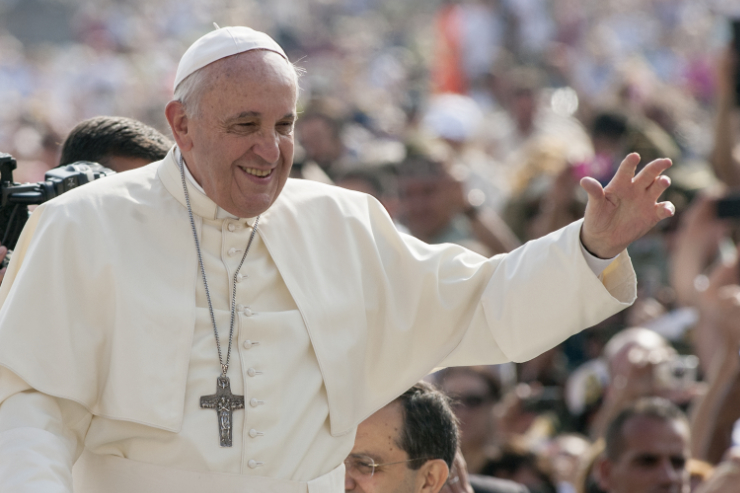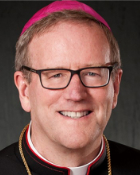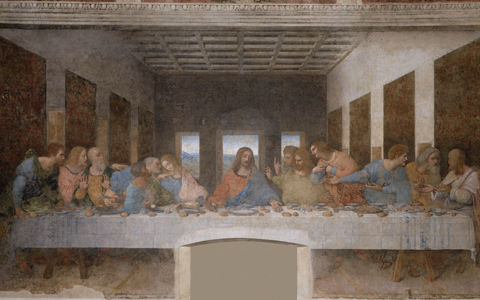I write these words from the Eternal City of Rome, whither I’ve come with my brother bishops from Region 11 (California, Nevada, and Hawaii) for our ad limina visit. This is a regular and canonically required trip to pray at the limina apostolorum (the threshold of the Apostles), the tombs of Saints Peter and Paul, and to meet with the successor of Peter. Yesterday was the first official day of the pilgrimage, and it was extraordinary indeed. We gathered early in the morning for Mass in the crypt of St. Peter’s Basilica, in the presence of the tomb of the Galilean fisherman to whom Jesus gave the keys of kingdom of heaven. And then, just about a half-hour later, we were ushered into the Apostolic Palace, and after traversing a number of elaborately decorated corridors and receiving a few salutes from Swiss Guards (I’ll confess that I rather like the salutes!), we lined up to meet the Pope.
Editor’s Note: Bishop Barron’s article appeared January 28, 2020 on the Word on Fire website and is presented here with the kind permission of the author.
Pope Francis was in remarkably good form, especially considering that he is a man of eighty-three years. He was friendly, warm, and energetic, and he engaged with each bishop as we entered the room. Once settled into elegant but rather uncomfortable chairs (one of my brother bishops said that he thought they had last been used during the Spanish Inquisition!), we commenced an extremely lively conversation with the Bishop of Rome. Francis spoke exclusively in Italian, while about two-thirds of us spoke to him in Spanish and about a third in English. It would be impossible to summarize what turned out to be a three-hour dialogue in the scope of this brief article, but I can mention a few major motifs.
First, Pope Francis was extremely interested in prayer. He spoke with real feeling about the importance of initiating our young people into the practice of Eucharistic Adoration. Several times he repeated the word “adoration,” urging us to teach our people this most fundamental form of communing with God. And in regard to bishops, he indicated several forms of “vicinanza” (closeness) that ought to characterize our lives: closeness to our people, to our brother bishops, and to our priests. But then he emphasized that all of these are grounded in the most important kind of vicinanza—namely, the intimacy with the Lord that comes through prayer. I will confess that these words of his have already burned their way into my mind and heart: “The first task of the bishop is to pray.”
A second theme that the Pope articulated with particular clarity and passion was that of gender ideology. As he has often in the past, he bemoaned the “ideological colonization” that takes place when Western notions of gender fluidity and self-invention make their way aggressively into parts of the developing world, often through a kind of blackmail: unless and until you adopt Western values in this regard, we will refuse you material and medical assistance. The Pope’s fundamental argument was biblical. The book of Genesis tells us that God made the genders distinct and that this difference is key to human flourishing. Whatever seeks to eliminate difference in this arena of life, therefore, is contrary to God’s will.
But by far the dominant theme in our lengthy conversation, expressed both in the questions of the bishops and the substantive responses of the Pope, was evangelization. When one bishop made reference to Evangelii Gaudium, Francis’s seminal encyclical on the topic, the Pope wryly commented that that text was largely “plagiarized” from St. Paul VI’s 1975 encyclical Evangelii Nuntiandi and the document that emerged from the meeting of the Latin American Bishops’ Conference at Aparacida in 2007. All three statements are, in fact, landmarks of the New Evangelization, and all three operate out of the assumption that the Church is missionary by its very nature. When I had a chance to speak, I asked the Pope to elaborate on the theme of the via pulchritudinis (the way of beauty), which is central to Evangelii Gaudium. He spoke of the recovery of beauty in the work of contemporary theologians and philosophers, and he urged us not to denigrate the beautiful as it is found in the popular culture—film, books, sports, etc.—which often appeal to the young more than some expressions of beauty in the high culture.
The most clarifying moment regarding evangelization occurred when a bishop asked the Pope to address what appeared to the bishop as something of a tension in the Pope’s teaching. On the one hand, he said, Francis seemed very strong in his recommendation that we announce the faith publicly and draw people to Christ, but on the other hand, the Holy Father frequently inveighs against what he calls “proselytizing.” I will confess that I have often wondered at some of Francis’ rhetoric here and have longed for something like his definition of the term. The Holy Father clarified that he, of course, advocates the spreading of the faith, but he is opposed to an aggressive, divisive, numbers-oriented approach to the task. Evangelization, he joked, is not like getting people to join your football club! As he often has in the past, he emphasized with us the centrality of personal witness to the joy of living a life of faith. Whatever teaching we do, he said, must take place within the context of that way of life. In this, of course, he was simply echoing Pope Paul VI, who said that people today listen to teachers precisely in the measure that those teachers are also witnesses. I was particularly gratified to hear him on this point, for there have been some in the commentariat who have suggested that engaging in apologetics or theological clarification is tantamount to “proselytizing.” Not according to Pope Francis.
Before I posed my question, I told the Pope that we were all grateful to him for giving us the opportunity to be with him as a true spiritual father. And that indeed is what the experience was like: our father speaking to us from the heart and with great affection. It was an encounter that I will not soon forget.
Please share on Facebook and other social media.
















